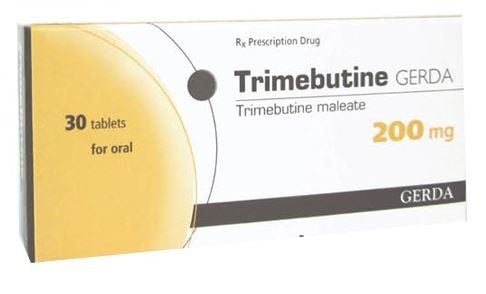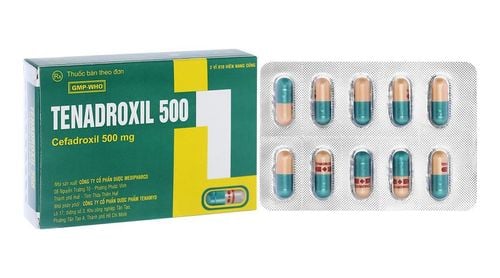This is an automatically translated article.
Macrolacin drug with the main ingredient is Clarithromycin 500mg, which is indicated for the combined treatment of H. pylori eradication in peptic ulcer disease, skin and soft tissue infections, and respiratory tract infections. Here are some useful information about Macrolacin drug to help patients learn and use the drug safely and effectively.
1. What is Macrolacin?
Macrolacin 500mg drug is a drug belonging to the group of drugs for parasites, anti-infectives, antivirals, antifungals. Macrolacin is manufactured by OPV Pharmaceutical Joint Stock Company, manufactured in the form of long film-coated tablets and packaged in boxes of 2 blisters x 7 tablets.
Macrolacin medicine has the main ingredient Clarithromycin 500mg and some other excipients just enough for 1 long tablet.
2. What are the effects of Macrolacin?
Macrolacin medicine is indicated for the treatment of patients in the following cases:
Treatment of tonsillitis, otitis media, acute sinusitis, pharyngitis. Treatment of chronic bronchitis with exacerbations, skin and soft tissue. Treatment of pneumonia caused by Mycoplasma pneumoniae and Legionella, diphtheria, early stage of whooping cough, opportunistic infections caused by Mycobacterium. Macrolacin is used in combination to eradicate Helicobacter pylori in peptic ulcer. Prophylaxis of disseminated Mycobacterium avium complex (MAC) infections in patients with advanced HIV infection.
3. Dosage - How to take Macrolacin
3.1. How to use the drug Macrolacin is prepared in the form of long film-coated tablets, which are tolerated by the body by mouth, according to tablets. Macrolacin can be taken before or after meals.
3.2. Dosage The dosage of Macrolacin drug depends on each subject and the course of the disease, there will be an appropriate dose. Below is the reference dose of Clarithromycin as follows:
For adults:
The dose is 250mg of Clarithromycin/day, divided into 2 oral doses a day. The course of treatment is for 7 days. Or 500mg of Clarithromycin modified-release orally once a day. In case of severe infection, the dose can be increased to 500mg Macrolacin/day, divided into 2 doses per day. Or 1000mg of Macrolacin modified-release once a day for up to 14 days. For children > 12 years: Use Macrolacin at the same dose as adults.
For children < 12 years old: Use Macrolacin emulsion for pediatric patients:
Daily dose is 7.5 mg/kg, divided into 2 oral doses a day. The maximum dose for children is 500 mg. The duration of treatment with Macrolacin is usually 7-10 days depending on the strain causing the disease and whether the disease is severe or mild. Treatment of strep throat requires at least 10 days of using Macrolacin. The prepared suspension can be taken without or with meals, and taken with milk. Using Macrolacin to eradicate H. pylori in duodenal ulcer patients:
For adults: The usual dose of Clarithromycin is 500mg/day twice a day for 7 days. The drug should be used with Omeprazole 40mg orally twice a day. For the elderly: Use the drug at the same dose as adults. For patients with renal impairment: Usually no dose adjustment is required except in patients with severe renal impairment with creatinine clearance less than 30ml/min. If dose adjustment is required, the total daily dose should be halved (eg, 250 mg once daily or 250 mg twice daily in severe cases).
4. What to do when using an overdose of Macrolacin?
In the case of patients using Clarithromycin in large quantities, an overdose of the drug than indicated will cause some symptoms in the gastrointestinal tract, this has been recorded in the drug reports.
Treatment:
Patients need gastric lavage and supportive treatment when experiencing symptoms of overdose. As with other macrolides, the clarithromycin component of the drug will not be removed by hemodialysis or peritoneal dialysis.
5. What should I do if I miss a dose of Macrolacin?
If the user forgets to take a dose according to the treatment plan, take the medicine as soon as he remembers it. But if it's almost time for your next dose to remember, skip the missed dose and take your next dose at the scheduled time. Users should pay attention not to double the prescribed dose, to avoid causing an overdose.
6. In which cases is Macrolacin not used?
Some contraindications, it should be noted when using Macrolacin for treatment as follows:
Do not use Macrolacin for patients with a history of hypersensitivity to Clarithromycin, other macrolide antibiotics and other drugs. other excipients in the drug. Clarithromycin should not be used with Ergot derivatives. Clarithromycin should not be used with any of the following: Cisaprid, Pimozide and Terfenadine. Increased concentrations of Pimozide, Cisapid and Terfenadine have been reported in patients receiving both these drugs and clarithromycin. The result is QT prolongation and arrhythmias including ventricular tachycardia, torsades de pointes, and ventricular fibrillation. Similar effects have been observed with concomitant administration of Astemizol and other macrolides. Macrolacin should not be used during pregnancy and lactation: Several clinical animal studies have suggested embryotoxic effects, but only at doses with obvious maternal toxicity. The active substance clarithromycin has not been accurately reported in the milk of lactating animals and in human milk. The safety of Clarithromycin during pregnancy and breastfeeding has not been established. Therefore, Clarithromycin should not be used during pregnancy or lactation, unless the benefit outweighs the risk to the patient.
7. Macrolacin drug interactions
Here are some interactions of Macrolacin with drugs as follows:
Clarithromycin should not be used with oral contraceptives because there has been no proven interaction. Use of Clarithromycin in combination with oral drugs that are metabolized by the cytochrome P450 system such as: Warfarin, Ergot alkaloids, Triazolam, Lovastatin, Disopyramide, Phenytoin and Cyclosporin. Very likely to increase the serum concentration of that drug. Administration of Clarithromycin to patients receiving Theophylline increases serum Theophylline concentrations and potential toxicity of Theophylline. Concomitant use of Klacid with Digoxin may increase the effectiveness of Digoxin. Therefore, serum digoxin concentrations should be closely monitored. Use of Clarithromycin may increase the potency of Carbamazepine by reducing the rate of excretion. Clarithromycin should be avoided in patients taking terfenadine and any related non-sedating antihistamines such as astemizole. Since macrolides have been reported to alter the metabolism of terfenadine, increased concentrations of terfenadine have been reported. Clarithromycin in combination with zidovudine in HIV-infected adult subjects may decrease steady-state zidovudine concentrations. The decrease in zidovudine concentrations can be largely avoided by arranging doses of Zidovudine and Klacid at intervals of 1-2 hours. There have been no reports of such reactions in children. Plasma concentrations of Omeprazole and clarithromycin may be increased when given concurrently, no dosage adjustment is required. Increased plasma clarithromycin concentrations may also occur when co-administered with Maalox or ranitidine. No dosage adjustment is required. Do not use Clarithromycin in combination with Pimozide, Cisapride and Terfenadine drugs will increase the concentration of this drug. This combination may prolong QT interval and arrhythmias including ventricular tachycardia, torsades de pointes, and ventricular fibrillation. Similar effects have also been observed when clarithromycin is co-administered with astemizole.
8. What side effects does Macrolacin cause?
The component Clarithromycin contained in the drug was well tolerated. Patients using the drug may experience some of the following undesirable effects:
Allergic reactions on the skin from mild to severe. Gastrointestinal: Nausea, vomiting, loss of appetite, diarrhea, dyspepsia and abdominal pain Stomatitis, granulomatous in the mouth and glottis. Allergic reactions range from urticaria and mild skin rash to anaphylaxis and Stevens-Johnson syndrome (rare). Nervous and Psychiatric: Dizziness, headache, anxiety, confusion, insomnia, nightmares, hallucinations, psychosis. Taste disturbances may occur, but are uncommon. Reversible loss of color on the tongue. Reduced hearing. Pseudomembranous colitis. Hepatobiliary: Disorders of liver function tests, liver failure. Other adverse effects: QT prolongation, rare torsades de pointes, and ventricular tachycardia. When the patient experiences any side effects of the drug while using the drug, it is necessary to inform the doctor. With mild adverse reactions will decrease and disappear when the drug is discontinued. In case of severe hypersensitivity or allergic reaction, it is necessary to conduct supportive treatment (keep breathing and use epinephrine, use antihistamines, oxygen breathing, corticosteroids...).
9. Precautions when using Macrolacin
This antibiotic should be used with caution in patients with impaired liver or kidney function. Because, the Clarithromycin component is excreted mainly by the liver and kidneys.
When patients use clarithromycin prolonged and repeated can cause the growth of fungi or bacteria that are no longer sensitive to the drug. If superinfection occurs, clarithromycin should be discontinued and appropriate therapy instituted.
In a small number of patients, H.pylori bacteria can become resistant to clarithromycin.
Patients receiving clarithromycin while taking drugs that are metabolized by the cytochrome P450 system may increase serum concentrations of those drugs.
Clarithromycin can be used without dose adjustment in patients with hepatic impairment and normal renal function. However, in the presence of renal impairment with or without hepatic impairment, it is necessary to reduce the dose or prolong the interval between doses.
Macrolacin has no influence on the ability to drive and use machines.
Clarithromycin should not be used during pregnancy and lactation, unless absolutely necessary.
Macrolacin medicine is prescribed by a doctor or pharmacist, patients do not arbitrarily use Macrolacin medicine without a prescription.













